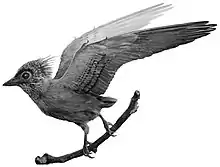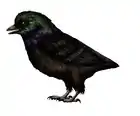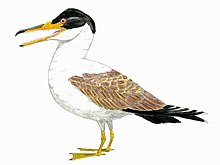| Elmisaurus Temporal range: Late Cretaceous, | |
|---|---|
 | |
| Skeletal restoration showing known elements (including those of Nomingia) | |
| Scientific classification | |
| Domain: | Eukaryota |
| Kingdom: | Animalia |
| Phylum: | Chordata |
| Clade: | Dinosauria |
| Clade: | Saurischia |
| Clade: | Theropoda |
| Family: | †Caenagnathidae |
| Subfamily: | †Elmisaurinae |
| Genus: | †Elmisaurus Osmólska, 1981 |
| Species: | †E. rarus |
| Binomial name | |
| †Elmisaurus rarus Osmólska, 1981 | |
| Synonyms | |
| |
Elmisaurus (meaning "foot sole lizard") is an extinct genus of caenagnathid dinosaur from the Late Cretaceous Nemegt Formation of Mongolia. It was a theropod belonging to the Oviraptorosauria.
Discovery

In 1970, a paleontological Polish-Mongolian expedition discovered two fragmentary specimens of a small theropod in the Ömnögovĭ province of Mongolia. The type species, Elmisaurus rarus, was named and described by Halszka Osmólska in 1981. The generic name is derived from Mongol elmyi or ölmyi, "foot sole", as the type specimen consisted of a metatarsus. The specific name means "rare" in Latin. The holotype, ZPAL MgD-I/172, consists of a left metatarsus fused with the tarsalia. There are two paratypes: ZPAL MgD-I/98, consisting of a right hand and foot, and ZPAL MgD-I/20, the upper part of the left metatarsus of a larger individual.[1]
In a 2001 study conducted by Bruce Rothschild and other paleontologists, 23 foot bones referred to Elmisaurus were examined for signs of stress fracture, but none were found.[2]
A second species, E. elegans, was named in 1989 by Philip J. Currie.[3] This represented a North American form originally described as a species of Ornithomimus by William Arthur Parks in 1933, based on specimen ROM 781, a foot.[4] Currie also referred the material of the American form Caenagnathus sternbergi, based on a jaw fragment, to Elmisaurus elegans. Due to their poor preservation and geographical distance from the type species, the classification of the American forms has been contentious. In 1997, Hans-Dieter Sues stated that this supposed second species of Elmisaurus should be referred to Chirostenotes, as C. elegans,[5] though this position was not accepted by Currie.[6] Other researchers, including Teresa Maryańska, Halszka Osmólska, and their colleagues, followed Sues in reassigning E. elegans to Chirostenotes.[7] In 2020, Gregory Funston assigned the material to the new genus and species Citipes.[8]
A 2021 article by Funston and colleagues suggested Nomingia is a synonym of Elmisaurus.[9]
Classification

The cladogram below follows an analysis by Longrich et al. in 2013, which found Elmisaurus to be a Caenagnathid.[10]
| Caenagnathidae |
| |||||||||||||||||||||||||||||||||||||||||||||
See also
References
- ↑ Osmólska, H. (1981). Coossified tarsometatarsi in theropod dinosaurs and their bearing on the problem of bird origins. Palaeontologica Polonica 42:79-95.
- ↑ Rothschild, B., Tanke, D. H., and Ford, T. L., 2001, Theropod stress fractures and tendon avulsions as a clue to activity: In: Mesozoic Vertebrate Life, edited by Tanke, D. H., and Carpenter, K., Indiana University Press, p. 331-336.
- ↑ Currie, P.J. (1989). "The first records of Elmisaurus (Saurischia, Theropoda) from North America." Canadian Journal of Earth Sciences 26(6):1319-1324
- ↑ Parks, W.A. (1933). New species of dinosaurs and turtles from the Upper Cretaceous formations of Alberta. University of Toronto Studies, Geological Series 34:1-33.
- ↑ Sues, H.-D. (1997). "On Chirostenotes, a Late Cretaceous oviraptorosaur (Dinosauria: Theropoda) from western North America." Journal of Vertebrate Paleontology 17(4):698-716.
- ↑ Currie, P.J., 2005, "Theropods, including birds". In: Currie, P.J. and Koppelhus E.B. (eds). Dinosaur Provincial Park, a spectacular ecosystem revealed, Part Two, Flora and Fauna from the park. Indiana University Press. pp. 367-397
- ↑ Maryanska, Osmolska and Wolsan, (2002). "Avialan status for Oviraptorosauria." Acta Palaeontologica Polonica, 47(1): 97-116.
- ↑ Funston, Gregory (2020-07-27). "Caenagnathids of the Dinosaur Park Formation (Campanian) of Alberta, Canada: anatomy, osteohistology, taxonomy, and evolution". Vertebrate Anatomy Morphology Palaeontology. 8: 105–153. doi:10.18435/vamp29362. ISSN 2292-1389. S2CID 221067979.
- ↑ Funston, Gregory F.; Currie, Philip J.; Tsogtbaatar, Chinzorig; Khishigjav, Tsogtbaatar (2021). "A partial oviraptorosaur skeleton suggests low caenagnathid diversity in the Late Cretaceous Nemegt Formation of Mongolia". PLOS ONE. 16 (7): e0254564. doi:10.1371/journal.pone.0254564. PMC 8274908. PMID 34252154.
- ↑ Longrich, N. R.; Barnes, K.; Clark, S.; Millar, L. (2013). "Caenagnathidae from the Upper Campanian Aguja Formation of West Texas, and a Revision of the Caenagnathinae". Bulletin of the Peabody Museum of Natural History. 54: 23–49. doi:10.3374/014.054.0102. S2CID 128444961.

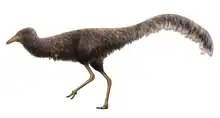

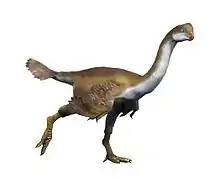
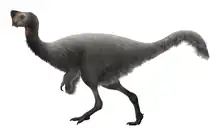



.png.webp)


.jpg.webp)
